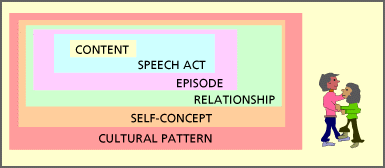

 TUTORIAL: INTERACTION AND RELATIONSHIPS
TUTORIAL: INTERACTION AND RELATIONSHIPSINTRODUCTION . NON-VERBAL COMMUNICATION . KINESICS . DISTANCE AND ARRANGEMENT . SPEECH ACTS . RELATIONSHIPS . KNOWING OTHERS . SELF-DISCLOSURE . PUNCTUATION . COORDINATED MANAGEMENT OF MEANING .
Coordinated Management of Meaning (or, CMM, as it will be abbreviated here) is not a single theory -- rather, it is a unified collection of interrelated definitions and explanations, some of which have been presented in other sections of this tutorial. Taken together, the six elements of the CMM model define a hierarchy of situations and actions that describes the "communication dance."

According to CMM, each of us recognizes and makes use of the cultural patterns of our society. These are similar to what other models call "social conventions." Within those patterns, we "know who we are" -- that is, each of us posses a self-concept. When we interact with others we do so in the context of a relationship, and each contact occurs as a particular event or episode. Our face-to-face communication consists primarily of speech acts which frame the actual words, or the content, of our speech.
CMM focuses neither on the individual thoughts of the communicators, nor on the characteristics of the society in which they live. Instead, it focuses on the interaction between the communicators and among the communicators and the members of the society. It is this interaction that generates the meaning of the messages that are sent and received.
The next sections present each of the CMM levels along with examples that illustrate each in turn. To begin, imagine that there are two people who are about to communicate with one another in a face-to-face situation.

 information, as signs, and as the paradigms and syntagms of
language appears in many of the theories presented in this tutorial. In this case the content is a series of vocal sounds which the example represents by the string of symbols: "Where's the beef?" It is
important to see that the content, by itself, is not sufficient to establish
the meaning of the communication. All six levels of the model must work
together to do that.
information, as signs, and as the paradigms and syntagms of
language appears in many of the theories presented in this tutorial. In this case the content is a series of vocal sounds which the example represents by the string of symbols: "Where's the beef?" It is
important to see that the content, by itself, is not sufficient to establish
the meaning of the communication. All six levels of the model must work
together to do that.
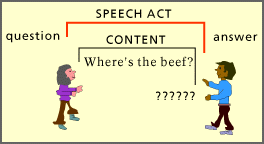 There are many different kinds of
illocutionary and perlocutionary acts -- questions, answers, commands,
promises, and so forht -- and the participants' knowledge of these plays a part in the communication.
There are many different kinds of
illocutionary and perlocutionary acts -- questions, answers, commands,
promises, and so forht -- and the participants' knowledge of these plays a part in the communication.
The phrase "Where's the beef?" could be a question -- that is, the speaker could be asking where she might find the beef, or it might be a statement -- that is, in response to the request "Name a famous fast food advertising slogan from the 1980s" she might respond, "Where's the beef?"
The exchange between the two communicants is constrained by the rules of the speech act. In this example we will stipulate that the speaker is asking a question -- this normally means that the receiver feels obligated to respond with a statement in the form of an "answer."
Although the type of speech act and the type of
episode both affect the meaning of the content, they are not independent of one
another. In other words the episode plays a part in determining which kind of
speech act is in use, and the speech acts play a part in defining the
episode. ![]() A Legal Episode
A Legal Episode
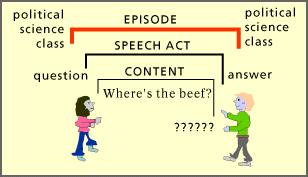
In this example we will now reveal that both communicants are participants in a college course in political science. HINT
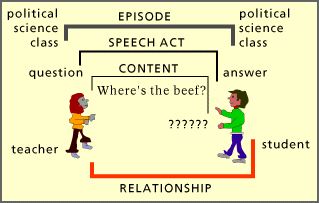
As was noted earlier, the levels of the CMM model affect one another. Thus, the
relationship level interacts with the episode, the speech act and the content. ![]() Child-Parent Relationship
Child-Parent Relationship
In this example we now reveal that the speaker is the teacher and the other participant a student.
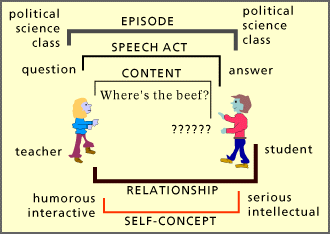
If the teacher sees herself as a somewhat humorous, interactive individual, then she probably presents many questions to her classes, and likely she presents some of them as interesting puzzles or jokes. If the student sees himself as a serious intellectual, then it is likely that he will try to respond with the correct answer to the teacher's question.
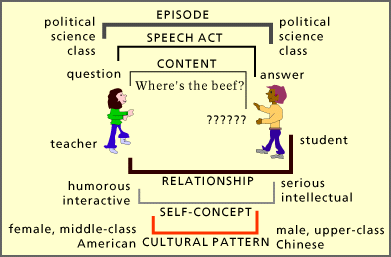
In this example suppose that the teacher is a woman with a middle-class American cultural
background. Given her self-concept we might expect her to conduct class in a
relaxed setting with much weight put on classroom discussion. And, suppose that the student is a
man with an upper-class Chinese cultural background. In a traditional Chinese
educational setting, students are expected to pay a great deal of respect to
their teachers and to remain quiet unless called upon.
![]() 4015
4015
In this case, then, the student might find himself in an uncomfortable setting
with a teacher who is acting in what seems to be a strange and
unpredictable manner. On the other hand, the teacher might feel that the
student is unprepared, not very bright, extremely shy or otherwise unable to
participate in the class. Because of their diverse cultural backgrounds, they
may have difficulty doing the communication dance. [The Dance]
![]() 4024
4024
![]() 4032
4032
In summary, notice once again that the Coordinated Management of Meaning model focuses neither on the individual thoughts of the communicators, nor on the specific characteristics of the society in which they live. Instead, it focuses on the interaction between the communicators within the context the society. It is this interaction that generates the meaning of the messages that are sent and received.